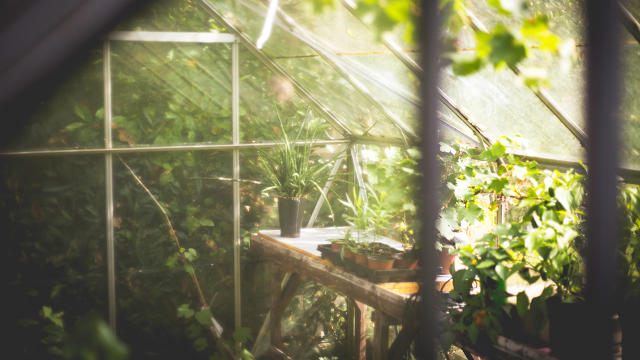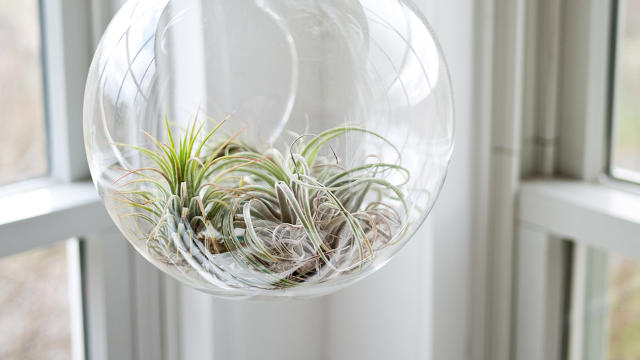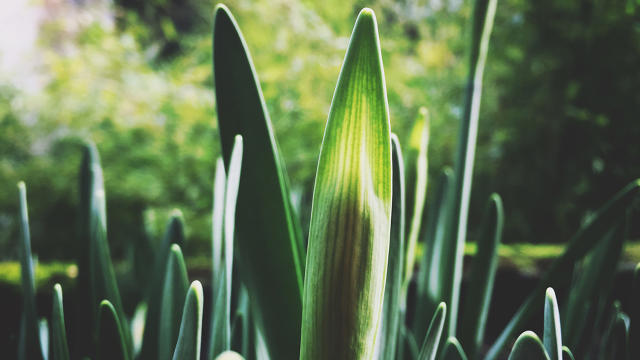As winter recedes and we dig our slightly lighter clothes out from the back of our closets, our thoughts turn to vegetables and flowers—even if, for city dwellers, our growing spaces are limited to balconies, rooftops, fire escapes, sunny windowsills, and tiny backyards. But these meager spaces shouldn’t deter us; it’s surprisingly easy (and fun!) to grow all kinds of pretty and delicious plants even without a lush suburban yard.
Maureen O’Brien, a community field manager at the Brooklyn Botanic Garden, walked us through some of the many easy ways to plant a garden, even in a small space. The key limiting factor in what you can plant, says O’Brien, is sun. She divides the possibilities for small-space gardens into three categories: shady, part-sun, and sunny. Full sun is going to be unusual in an urban environment: trees, other buildings, fences, and all kinds of other obstacles are likely to block sunlight for at least part of the day. Partial sun, generally, is what we urbanites might think of as “extremely sunny,” consisting of unblocked sun for around four to six hours per day. Anything under four hours is considered shady—if you’re looking at under two hours a day, you’ll be restricted to plants that need basically no sun at all.

Steal My Sunshine
If your growing space has a mere few hours of sun per day—this might include something like a sunny window—you still have options.
First, you’ll need a container. You might be surprised that those expensive glazed or terracotta pots, while beautiful, offer absolutely no advantage to growing plants besides looking nicer than, say, a plastic bucket. “Plastic quart takeout containers would work fine for herbs; or you can get an expensive glazed pot, and that works fine, too,” says O’Brien. We love Home Depot’s five-gallon “Homer” bucket ($3.42 each) for big stuff, and its “Norcal” terracotta pots ($1.32 each) for little stuff. If you want something a bit more stylish, Crate & Barrel make really beautiful two-tone planters ($6.95-$49.95). There’s always Ikea, which typically has a solid selection of inexpensive planters, or you can buy plain boards ($7.98) and make them yourself:
The key is to make sure the container has a hole in it, preferably around the sides, about an inch up from the bottom, to provide proper drainage. You’re a garden noob and may accidentally overwater, so drain holes let any excess water escape without rotting the roots. You could insert a little piece of screen or a bit of fabric to block soil from coming out of the bottom, but you’ll still want to place a container like this on a catch saucer in case excess water comes out. If you’re doing a lot of gardening, you could opt for some weed-blocker fabric, which is effective and cheap at scale ($18 for 50 yards). An old T-shirt, honestly, will work as well. (I’ve typically just done without and accepted that a little soil will come out of the bottom with excess water.)
Be careful of window boxes that hang from a window ledge: for one thing, they can be dangerous if not properly attached, and for another, it’s trickier to plant a bunch of different plants in a single container. They can fight with each other for water or nutrients, and if they have different water needs, you’ll end up over- or underwatering something. If you do go for a window box, this one from WindowBox.com ($76.97) allows you to place individual pots in the window box holder.
You’ll need soil, too; in most urban environments, soil can be polluted and generally rocky, sandy, and depleted of nutrients. Better to buy some potting soil. For beginners, Miracle Gro or other boosted-nutrient soils work just fine, but for intermediate gardeners, O’Brien recommends going organic. “When you use Miracle Gro or things like that, it’s a big shock of nitrogen all at once, and it doesn’t stay in the soil,” she says. The nitrogen can soak into groundwater, which isn’t good, but it also has weird effects on the plant: O’Brien says she’s noticed that too much nitrogen can result in more succulent leaves, which can attract pests, as well as fewer fruits. Black Gold ($16.00 for four quarts) makes some good organic soil, or if you want to go the non-organic route, just snag some Miracle Gro. It’s available on Amazon ($7.49 for 1 cubic foot), but you’ll find more options if you go to a hardware store or a Home Depot or Lowe’s. (I’ve had good luck with Miracle Gro’s organic line, Nature’s Care. But don’t overthink it. Just buy some potting soil.)
You’ll want to grab some fertilizer, too. O’Brien recommends either a liquid fish emulsion or the granular version. Jobe’s is the go-to brand for organic fertilizers, and is very cheap ($8.24 for four pounds, easily enough for a couple of seasons). I’ve used a liquid fish-based fertilizer called “Neptune’s Harvest” for years, primarily because it has an amusing label. Exactly what sort of fertilizer you should use actually varies by plant, soil type, and pH levels, but for starting out, just follow the directions and err on the side of underfertilizing.
So what can you grow in a difficult, shady spot? Edibles can be tricky, but a few herbs will grow happily without much sun. Mint is a great option, as are chives. They grow without much effort on your part and are hearty enough to withstand your mistakes. For non-edible options, O’Brien recommends “amaryllis or other bulbs, something where the energy’s already in the bulb.” Amaryllis bulbs (various prices, but don’t spend more than about $12)—produce absolutely stunning gigantic pink-and-white flowers with minimal effort. Ferns and many other houseplants are also pretty shade tolerant. You can buy some of these online easily; Amazon sells a rubber tree ($18-ish) that’ll arrive already planted and will eventually grow to six feet or taller. There are also lots of plant starters available inexpensively on eBay.
Beginners will want to go with seedlings instead of seeds. “Most seed packets have enough seeds to grow a 100-foot row of plants,” says O’Brien, and you certainly don’t need that. And some plants are tricky to grow from seed: “Parsley takes, like, three weeks to germinate,” she says. Don’t bother: Grab some seedlings from a local garden store or farmer’s market.

I’ve Got A Pocketful Of Sunshine (And Literally No More)
So you’ve got a little more sunshine than just a window—perhaps a deck or a south-facing window. Now you’ve got some options. First of all, go bigger: The size of your container will heavily affect the size of your final plant. Always go bigger than you think you need, and never overcrowd plants. Those gigantic five-gallon containers from Home Depot are good for, believe it or not, a single tomato plant or chili pepper plant. Don’t try to put in more; the plants will fight each other rather than grow tall and strong.
For intermediate gardeners, you can make a pretty amazing drainage system out of those buckets. Fill them with gravel ($11.69 on Amazon) up to a couple inches from the bottom of the bucket, then lay a layer of fabric (weed blocker is good, but honestly cotton will work fine) over top of that, then fill up the bucket the rest of the way with soil. This strategy gives you a much more regulated drainage system and will help your soil resist mold and sitting water.
Be careful if you’re planting multiple plants together; look at the tags to make sure they have the same requirements in terms of sunlight and water. Some plants naturally work together; “If it was an herb box, and you had parsley, basil, mint, and cilantro? Those are all kind of similar, they like a lot of water and would do best under full sun,” says O’Brien. But others, like sage, thyme, and oregano, need less water and less sun, and wouldn’t do as well under the same conditions.
Part-sun environments really open up what you can grow. Greens are incredibly easy, and for intermediate gardeners are a great way to play around with seeds. Lettuces, arugula, and chard are all super simple to grow, and germinate quickly.
Beginners and intermediates alike can opt, finally, for some non-leaf edibles as well. Tomatoes are easy to grow, but be careful about what kind you choose: O’Brien recommends cherry or grape tomatoes, which give harvests throughout the summer and can handle less sunlight and less space a lot more readily than, say, a beefsteak. Chili peppers are also incredibly easy to grow. If you’re starting from seed, O’Brien recommends seeds from Renee’s Garden, which you can find for about $3.00 per packet. From seedlings? Just head to your farmers’ market or hardware store.
With part sun, you’ll also probably encounter pests. Even in an urban environment, there are plenty of bugs (and even squirrels and pigeons) that are just as eager as you are to chomp down on some fresh local produce. Addressing bugs doesn’t have to be complicated: A simple solution of a tablespoon or two of dish soap to a quart of water in a spray bottle and squirted onto leaves and stems will discourage most bugs.
As for watering, again you can go as simple or as complicated as you want. The only real rule is to not over- or underwater, and to water directly into the soil where the stem emerges. Don’t ever water the leaves—they can get moldy and die—although certain plants can enjoy a nice misting of water on their leaves. (Again, refer to the seed packet or tag.)
Black Whole Sun
You’ve got rooftop access or a sunny backyard, so the sky’s the limit now—or, rather, your available space is the limit. A key mistake that many early gardeners make is picking the wrong kind of crop for a small space. Root vegetables are fun—”It’s really something to pull a carrot out of the ground,” says O’Brien—but because you’re eating the root of the plant, you only get one harvest per year, which makes it not a good use of space.
Ditto to gigantic plants like pumpkin, butternut squash, and watermelon. They’ll grow, but not all that well; these plants tend to want to cover the entire ground, and don’t play nice with other crops. And forget corn: Like carrots, it’s really fun, but the amount of space you need to grow even a meal’s worth of corn is probably more than you have in total.
Instead, opt for smaller fruits and vegetables: tomatoes and chili peppers, sure, but also zucchini, eggplant, cucumbers, and beans. Follow the directions on the package for these: Some, like cucumbers and beans, are climbers. Intermediate urban farmers can use an extremely old Native American technique for planting multiple items at once: You can stake or trellis your climbers, then grow ground-covering plants underneath them, like greens or herbs. You get double the crop in the same amount of space. You can get a cheapie wooden trellis for about $18.00, or you can go for beautiful elaborate wrought-iron trellises like this one ($387, which would be, frankly, insane), but they’ll work about the same. (Trellises are a great opportunity for a DIY project.)
With full sun, you might want to investigate a raised planter instead of using containers. This is a bit more effort, but could be worth it: You give your plants a little more room to stretch their roots and grow bigger and stronger. O’Brien recommends the “square foot gardening” system, which blocks off a raised bed into individual sectors to ensure plants grow unimpeded by others in a raised bed. And you can buy the boxes or other setups for that system already put together, or you can opt for a simpler wooden one ($69.99).
If you have a more elaborate raised bed garden, it’s worth it to figure out some kind of automatic watering system. That’ll allow you to leave for a day or a week and not worry about all your hard work going to waste, and will make sure your plants are happy. There are plenty of options, ranging from low-tech drip systems to smartphone-controlled Wi-Fi-enabled gadgets; this is a good guide to get you started.

The Best Gardening Gadgets
It’s likely you’ve read our dead-simple advice above and thought one of two things: Doesn’t everyone know this already? or Isn’t there an Uber for plants? To your first thought I’d reply (in this scenario, I’m a telepath): You’d be surprised. I’ve helped several of my New York City-based friends learn to grow plants over the years, and sometimes even just the basics of watering and draining have been shockingly novel to them. Not everyone actually knows how trees grow in Brooklyn.
As for automation, there is no shortage of off-the-shelf solutions to help you grow herbs and flowers. Some of them are even pretty good! But they’re certainly not as inexpensive as a DIY solution, and many of them won’t present you with the opportunity to learn the basics of gardening that will let you advance to trickier varieties of plants. Still, any method that gets you into the joys of having fresh greens at hand is a win.
Gardening gadgets can be roughly split into two categories: Monitoring solutions that keep track of soil dryness or nutrient balance, and all-in-one growing systems that typically forgo soil for hydroponic, water-based gardening.
Out of all of the monitoring gadgets—the Parrot Flower Power ($55); the Oso PlantLink ($45); the Spruce Irrigation system ($250+)—there are only a couple I’d actually recommend to the casual apartment gardener: the Chirp! water sensor from Adafruit ($16, with battery), which is a simple stick that sits in a pot and makes a little buzzing noise when things get too dry; or the Dr. Meter hydrometer ($16 for two), a clever little analog device that doesn’t even need batteries to operate. Both are highly rated (and regarded) and do the only thing you really need, which is to give you a second opinion about when it’s time to water. And since it’s likely that you’ll be watering all your plants at once, using one monitor in a single pot should be reminder enough that your plants need a little sip. (Bigger pots and bigger plants will go through water at different rates, but you can always just move the monitors to double-check what your finger in the soil tells you.)
Another simple tool? A reminder in your favorite calendar or to-do app that reminds you every two to three days to give your plants a drink.
If you want to skip the pots and soil entirely, there are several all-in-one hydroponics kits around these days, including the category pioneering AeroGrow/AeroGarden ($87-$112, depending on add-ons), now a division of MiracleGro. These units are about as basic as they come: A water tub at the bottom, some dangling, foam-filled seed pods in the middle, and some sort of grow light on top. I used the first Aerogrow almost a decade ago and found it to be pretty satisfying, albeit without the joy of playing with dirt. These sorts of systems come with their own drawbacks: you can’t really grow root vegetables, and you’ll have to tear them apart every month or two to clean out the insides to keep them from getting scummy with algae. That said, they couldn’t be any easier to use, and even though the prepackaged seed pods are hilariously expensive compared to buying seeds in packets, I have ripped out the old root systems and planted new seeds without any issue. There are a few new contenders in the space, like the Click & Grow ($60) which has an ever-so-slightly classier design, or the Modern Sprout hydroponic system ($150+) which is clad in real wood and downright attractive. They all work in essentially the same way, so if you’re just trying to get bunches of fresh herbs on your shelf—and the units with grow lights make it possible, say, even in non-windowed kitchens—you can’t really make a bad choice.
There are a couple of other categories of gardening gadgets that can be safely ignored for now: super “smart” planters, with Internet-Of-Things integration and other whiz-bang features, like the AliGro or the nthing Planty pot, which are intriguing but far too expensive and unproven for the starting gardener; and grow lights. If you absolutely feel that grow lights are a solution for your black thumb—and as an owner of a few in my apartment garden, I can assure you they are not—take a look at some of the newer, LED-based versions that use a little less electricity than incandescent models. Be ready for an apartment filled with purplish-blue light, though, and for neighbors who knock on your door asking about your stash.

Fine, I’ll Grow Something!
The real takeaway here is that gardening is incredibly easy, calming, and rewarding. A takeout container that used to hold wonton soup, plus some soil from Amazon and a nice little seedling from your farmers market, can produce herbs, fruits, vegetables, or flowers. Don’t overthink it: You’ll make mistakes, you’ll lose a few plants to inexperience, but growing plants is a way to liven up your living space and help you quiet—if it’s just for a few minutes a day—the insane bustle of city living.
(58)